
Armorial of the Holy Roman Empire
Encyclopedia

Holy Roman Empire
The Holy Roman Empire was a realm that existed from 962 to 1806 in Central Europe.It was ruled by the Holy Roman Emperor. Its character changed during the Middle Ages and the Early Modern period, when the power of the emperor gradually weakened in favour of the princes...
used many different heraldic
Heraldry
Heraldry is the profession, study, or art of creating, granting, and blazoning arms and ruling on questions of rank or protocol, as exercised by an officer of arms. Heraldry comes from Anglo-Norman herald, from the Germanic compound harja-waldaz, "army commander"...
forms, representing its numerous internal divisions.
Holy Roman EmperorHoly Roman EmperorThe Holy Roman Emperor is a term used by historians to denote a medieval ruler who, as German King, had also received the title of "Emperor of the Romans" from the Pope...
s
Starting with Albert IIAlbert II of Germany
Albert the Magnanimous KG was King of Hungary from 1438 until his death. He was also King of Bohemia, elected King of Germany as Albert II, duke of Luxembourg and, as Albert V, archduke of Austria from 1404.-Biography:Albert was born in Vienna as the son of Albert IV, Duke of Austria, and Johanna...
(reigned 1438–39), each Emperor
Holy Roman Emperor
The Holy Roman Emperor is a term used by historians to denote a medieval ruler who, as German King, had also received the title of "Emperor of the Romans" from the Pope...
bore arms with an inescutcheon of his personal arms on the torso of a two-headed eagle. (Before 1438 the Emperors would have both a personal and an imperial coat of arms
Coat of arms
A coat of arms is a unique heraldic design on a shield or escutcheon or on a surcoat or tabard used to cover and protect armour and to identify the wearer. Thus the term is often stated as "coat-armour", because it was anciently displayed on the front of a coat of cloth...
.) The arms of the High Offices of the Empire were borne as an augmentation
Augmentation of Honour
In heraldry, an augmentation is a modification or addition to a coat of arms, typically given by a monarch as either a mere mark of favour, or a reward or recognition for some meritorious act...
to the office-holder's personal arms.
| Personal arms | Imperial arms | Name/Blazon of personal arms |
 |
Hohenstaufen Hohenstaufen The House of Hohenstaufen was a dynasty of German kings in the High Middle Ages, lasting from 1138 to 1254. Three of these kings were also crowned Holy Roman Emperor. In 1194 the Hohenstaufens also became Kings of Sicily...
Or, three lions passant in pale sable. |
|
 |
Gules, two lions passant guardant Or. |
|
 |
Or, three lions passant in pale sable. |
|
 |
 |
Or, a lion rampant gules, armed, langued, and crowned azure. |
 |
 |
Azure, billetty a lion rampant with a closed crown Or, armed and langued gules. |
 |
 |
Gules a fess argent. |
 |
Barry of ten argent and azure, a lion rampant gules, crowned Or. |
|
 |
 |
Fusilly bendwise argent and azure. |
 |
 |
Gules a lion rampant argent, queue fourchée crossed in saltire, armed, langued, and crowned Or. |
 |
Quarterly, I and IV fusilly bendwise argent and azure (for Bavaria Bavaria Bavaria, formally the Free State of Bavaria is a state of Germany, located in the southeast of Germany. With an area of , it is the largest state by area, forming almost 20% of the total land area of Germany... ); II and III sable a lion rampant Or, armed, langued, and crowned gules (for the Electoral Palatinate). |
|
 |
Quarterly, I and IV gules a lion rampant argent, queue fourchée crossed in saltire, armed, langued, and crowned Or (for Bohemia Kingdom of Bohemia The Kingdom of Bohemia was a country located in the region of Bohemia in Central Europe, most of whose territory is currently located in the modern-day Czech Republic. The King was Elector of Holy Roman Empire until its dissolution in 1806, whereupon it became part of the Austrian Empire, and... ); II and III barry of eight, gules and argent (for Hungary Kingdom of Hungary The Kingdom of Hungary comprised present-day Hungary, Slovakia and Croatia , Transylvania , Carpatho Ruthenia , Vojvodina , Burgenland , and other smaller territories surrounding present-day Hungary's borders... ). |
|
 |
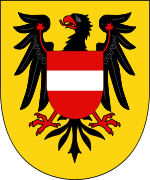 |
Gules a fess argent. |
 |
 |
Gules a fess argent. |
Per pale, dexter gules a fess argent (for Austria Archduchy of Austria The Archduchy of Austria , one of the most important states within the Holy Roman Empire, was the nucleus of the Habsburg Monarchy and the predecessor of the Austrian Empire... ); sinister bendy of six Or and azure, a bordure gules (for the French Duchy of Burgundy Duke of Burgundy Duke of Burgundy was a title borne by the rulers of the Duchy of Burgundy, a small portion of traditional lands of Burgundians west of river Saône which in 843 was allotted to Charles the Bald's kingdom of West Franks... ). |
||
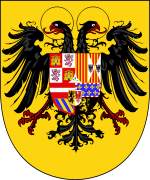 |
Quarterly: I and IV grand-quarterly i and iv great-grand-quarterly 1 and 4 gules a three towered castle Or masoned sable and ajouré azure (for Castile Kingdom of Castile Kingdom of Castile was one of the medieval kingdoms of the Iberian Peninsula. It emerged as a political autonomous entity in the 9th century. It was called County of Castile and was held in vassalage from the Kingdom of León. Its name comes from the host of castles constructed in the region... ), 2 and 3 argent a lion rampant purpure crowned Or langued and armed gules (for Leon Kingdom of León The Kingdom of León was an independent kingdom situated in the northwest region of the Iberian Peninsula. It was founded in AD 910 when the Christian princes of Asturias along the northern coast of the peninsula shifted their capital from Oviedo to the city of León... ), ii per pale, dexter per fess, in chief Or four pallets gules (for Aragon Kingdom of Aragon The Kingdom of Aragon was a medieval and early modern kingdom in the Iberian Peninsula, corresponding to the modern-day autonomous community of Aragon, in Spain... ), in base gules a cross, saltire, and orle of chains linked together Or and a centre point vert (for Navarre Kingdom of Navarre The Kingdom of Navarre , originally the Kingdom of Pamplona, was a European kingdom which occupied lands on either side of the Pyrenees alongside the Atlantic Ocean.... ), sinister argent a cross potent and four crosslets Or (for Jerusalem Kingdom of Jerusalem The Kingdom of Jerusalem was a Catholic kingdom established in the Levant in 1099 after the First Crusade. The kingdom lasted nearly two hundred years, from 1099 until 1291 when the last remaining possession, Acre, was destroyed by the Mamluks, but its history is divided into two distinct periods.... ) impaling barry of eight gules and argent (for Hungary Kingdom of Hungary The Kingdom of Hungary comprised present-day Hungary, Slovakia and Croatia , Transylvania , Carpatho Ruthenia , Vojvodina , Burgenland , and other smaller territories surrounding present-day Hungary's borders... ), iii per pale, dexter per fess, in chief Or four pallets gules (for Aragon Kingdom of Aragon The Kingdom of Aragon was a medieval and early modern kingdom in the Iberian Peninsula, corresponding to the modern-day autonomous community of Aragon, in Spain... ), in base gules a cross, saltire, and orle of chains linked together Or and a centre point vert (for Navarre Kingdom of Navarre The Kingdom of Navarre , originally the Kingdom of Pamplona, was a European kingdom which occupied lands on either side of the Pyrenees alongside the Atlantic Ocean.... ), sinister per saltire, 1 and 4 Or four pallets gules, 2 and 3 argent an eagle displayed sable (for Sicily Kingdom of Sicily The Kingdom of Sicily was a state that existed in the south of Italy from its founding by Roger II in 1130 until 1816. It was a successor state of the County of Sicily, which had been founded in 1071 during the Norman conquest of southern Italy... ); II and III grand-quarterly, i gules a fess argent (for Austria Archduchy of Austria The Archduchy of Austria , one of the most important states within the Holy Roman Empire, was the nucleus of the Habsburg Monarchy and the predecessor of the Austrian Empire... ), ii azure semy-de-lis Or a bordure compony Compone In heraldry, an ordinary componé, compony or gobony is composed of a row of panes of alternating tinctures; the ordinary thus affected is most often a bordure.... argent and gules (new Burgundy Duke of Burgundy Duke of Burgundy was a title borne by the rulers of the Duchy of Burgundy, a small portion of traditional lands of Burgundians west of river Saône which in 843 was allotted to Charles the Bald's kingdom of West Franks... ), iii bendy of six Or and azure a bordure gules (old Burgundy Duke of Burgundy Duke of Burgundy was a title borne by the rulers of the Duchy of Burgundy, a small portion of traditional lands of Burgundians west of river Saône which in 843 was allotted to Charles the Bald's kingdom of West Franks... ), iv sable a lion rampant Or langued and armed gules (for Brabant), overall at the fess point of the quarter an inescutcheon Or a lion rampant sable armed and langued gules (for Flanders) impaling argent an eagle displayed gules, armed, beaked, and langued Or (for Tyrol County of Tyrol The County of Tyrol, Princely County from 1504, was a State of the Holy Roman Empire, from 1814 a province of the Austrian Empire and from 1867 a Cisleithanian crown land of Austria-Hungary... ); enté en point argent a pomegranate proper seeded gules, supported, sculpted and slipped vert (for Granada Granada Granada is a city and the capital of the province of Granada, in the autonomous community of Andalusia, Spain. Granada is located at the foot of the Sierra Nevada mountains, at the confluence of three rivers, the Beiro, the Darro and the Genil. It sits at an elevation of 738 metres above sea... ). |
|
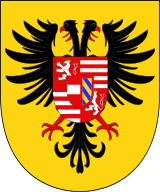 |
Quarterly, I and IV gules a lion rampant argent, queue fourchée crossed in saltire, armed, langued, and crowned Or (for Bohemia Kingdom of Bohemia The Kingdom of Bohemia was a country located in the region of Bohemia in Central Europe, most of whose territory is currently located in the modern-day Czech Republic. The King was Elector of Holy Roman Empire until its dissolution in 1806, whereupon it became part of the Austrian Empire, and... ); II and III barry of eight, gules and argent (for Hungary Kingdom of Hungary The Kingdom of Hungary comprised present-day Hungary, Slovakia and Croatia , Transylvania , Carpatho Ruthenia , Vojvodina , Burgenland , and other smaller territories surrounding present-day Hungary's borders... ); overall and inescutcheon per pale, dexter gules a fess argent (for Austria Archduchy of Austria The Archduchy of Austria , one of the most important states within the Holy Roman Empire, was the nucleus of the Habsburg Monarchy and the predecessor of the Austrian Empire... ), sinister bendy of six Or and azure, a bordure gules (for Burgundy Duke of Burgundy Duke of Burgundy was a title borne by the rulers of the Duchy of Burgundy, a small portion of traditional lands of Burgundians west of river Saône which in 843 was allotted to Charles the Bald's kingdom of West Franks... ). |
|
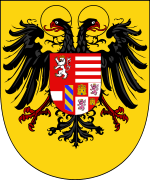 |
Quarterly, I gules a lion rampant argent, queue fourchée crossed in saltire, armed, langued, and crowned Or (for Bohemia Kingdom of Bohemia The Kingdom of Bohemia was a country located in the region of Bohemia in Central Europe, most of whose territory is currently located in the modern-day Czech Republic. The King was Elector of Holy Roman Empire until its dissolution in 1806, whereupon it became part of the Austrian Empire, and... ); II barry of eight, gules and argent (for Hungary Kingdom of Hungary The Kingdom of Hungary comprised present-day Hungary, Slovakia and Croatia , Transylvania , Carpatho Ruthenia , Vojvodina , Burgenland , and other smaller territories surrounding present-day Hungary's borders... ); III per pale, dexter gules a fess argent (for Austria Archduchy of Austria The Archduchy of Austria , one of the most important states within the Holy Roman Empire, was the nucleus of the Habsburg Monarchy and the predecessor of the Austrian Empire... ), sinister bendy of six Or and azure, a bordure gules (for Burgundy Duke of Burgundy Duke of Burgundy was a title borne by the rulers of the Duchy of Burgundy, a small portion of traditional lands of Burgundians west of river Saône which in 843 was allotted to Charles the Bald's kingdom of West Franks... ); IV grand-quarterly i and iv gules a three-towered castle Or (for Castile Kingdom of Castile Kingdom of Castile was one of the medieval kingdoms of the Iberian Peninsula. It emerged as a political autonomous entity in the 9th century. It was called County of Castile and was held in vassalage from the Kingdom of León. Its name comes from the host of castles constructed in the region... ), ii and iii argent a lion rampant purpure armed, langued, and crowned Or (for Leon Kingdom of León The Kingdom of León was an independent kingdom situated in the northwest region of the Iberian Peninsula. It was founded in AD 910 when the Christian princes of Asturias along the northern coast of the peninsula shifted their capital from Oviedo to the city of León... ). |
|
 |
Quarterly, I gules a lion rampant argent, queue fourchée crossed in saltire, armed, langued, and crowned Or (for Bohemia Kingdom of Bohemia The Kingdom of Bohemia was a country located in the region of Bohemia in Central Europe, most of whose territory is currently located in the modern-day Czech Republic. The King was Elector of Holy Roman Empire until its dissolution in 1806, whereupon it became part of the Austrian Empire, and... ); II barry of eight, gules and argent (for Hungary Kingdom of Hungary The Kingdom of Hungary comprised present-day Hungary, Slovakia and Croatia , Transylvania , Carpatho Ruthenia , Vojvodina , Burgenland , and other smaller territories surrounding present-day Hungary's borders... ); III grand-quarterly, i and iv gules a three-towered castle Or (for Castile Kingdom of Castile Kingdom of Castile was one of the medieval kingdoms of the Iberian Peninsula. It emerged as a political autonomous entity in the 9th century. It was called County of Castile and was held in vassalage from the Kingdom of León. Its name comes from the host of castles constructed in the region... ), ii and iii argent a lion rampant purpure armed, langued, and crowned Or (for Leon Kingdom of León The Kingdom of León was an independent kingdom situated in the northwest region of the Iberian Peninsula. It was founded in AD 910 when the Christian princes of Asturias along the northern coast of the peninsula shifted their capital from Oviedo to the city of León... ); IV per pale, dexter bendy of six Or and azure a bordure gules (for Burgundy Duke of Burgundy Duke of Burgundy was a title borne by the rulers of the Duchy of Burgundy, a small portion of traditional lands of Burgundians west of river Saône which in 843 was allotted to Charles the Bald's kingdom of West Franks... ), sinister per fess, chief argent an eagle displayed gules armed, langued, and beaked Or (for Tyrol County of Tyrol The County of Tyrol, Princely County from 1504, was a State of the Holy Roman Empire, from 1814 a province of the Austrian Empire and from 1867 a Cisleithanian crown land of Austria-Hungary... ), and base Or a lion rampant sable, armed and langued gules (for Flanders); overall an inescutcheon gules a fess argent (for Austria Archduchy of Austria The Archduchy of Austria , one of the most important states within the Holy Roman Empire, was the nucleus of the Habsburg Monarchy and the predecessor of the Austrian Empire... ). |
|
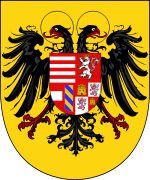 |
Quarterly, I barry of eight, gules and argent (for Hungary Kingdom of Hungary The Kingdom of Hungary comprised present-day Hungary, Slovakia and Croatia , Transylvania , Carpatho Ruthenia , Vojvodina , Burgenland , and other smaller territories surrounding present-day Hungary's borders... ); II gules a lion rampant argent, queue fourchée crossed in saltire, armed, langued, and crowned Or (for Bohemia Kingdom of Bohemia The Kingdom of Bohemia was a country located in the region of Bohemia in Central Europe, most of whose territory is currently located in the modern-day Czech Republic. The King was Elector of Holy Roman Empire until its dissolution in 1806, whereupon it became part of the Austrian Empire, and... ); III per pale, dexter gules a fess argent (for Austria Archduchy of Austria The Archduchy of Austria , one of the most important states within the Holy Roman Empire, was the nucleus of the Habsburg Monarchy and the predecessor of the Austrian Empire... ), sinister bendy of six Or and azure, a bordure gules (for Burgundy Duke of Burgundy Duke of Burgundy was a title borne by the rulers of the Duchy of Burgundy, a small portion of traditional lands of Burgundians west of river Saône which in 843 was allotted to Charles the Bald's kingdom of West Franks... ); IV grand-quarterly i and iv gules a three-towered castle Or (for Castile Kingdom of Castile Kingdom of Castile was one of the medieval kingdoms of the Iberian Peninsula. It emerged as a political autonomous entity in the 9th century. It was called County of Castile and was held in vassalage from the Kingdom of León. Its name comes from the host of castles constructed in the region... ), ii and iii argent a lion rampant purpure armed, langued, and crowned Or (for Leon Kingdom of León The Kingdom of León was an independent kingdom situated in the northwest region of the Iberian Peninsula. It was founded in AD 910 when the Christian princes of Asturias along the northern coast of the peninsula shifted their capital from Oviedo to the city of León... ). |
|
 |
Quarterly, I and IV gules a lion rampant argent, queue fourchée crossed in saltire, armed, langued, and crowned Or (for Bohemia Kingdom of Bohemia The Kingdom of Bohemia was a country located in the region of Bohemia in Central Europe, most of whose territory is currently located in the modern-day Czech Republic. The King was Elector of Holy Roman Empire until its dissolution in 1806, whereupon it became part of the Austrian Empire, and... ); II and III barry of eight, gules and argent (for Hungary Kingdom of Hungary The Kingdom of Hungary comprised present-day Hungary, Slovakia and Croatia , Transylvania , Carpatho Ruthenia , Vojvodina , Burgenland , and other smaller territories surrounding present-day Hungary's borders... ); overall and inescutcheon per pale, dexter gules a fess argent (for Austria Archduchy of Austria The Archduchy of Austria , one of the most important states within the Holy Roman Empire, was the nucleus of the Habsburg Monarchy and the predecessor of the Austrian Empire... ), sinister bendy of six Or and azure, a bordure gules (for Burgundy Duke of Burgundy Duke of Burgundy was a title borne by the rulers of the Duchy of Burgundy, a small portion of traditional lands of Burgundians west of river Saône which in 843 was allotted to Charles the Bald's kingdom of West Franks... ). |
|
Quarterly, I gules a three-towered castle Or (for Castile Kingdom of Castile Kingdom of Castile was one of the medieval kingdoms of the Iberian Peninsula. It emerged as a political autonomous entity in the 9th century. It was called County of Castile and was held in vassalage from the Kingdom of León. Its name comes from the host of castles constructed in the region... ); II barry of eight, gules and argent (for Hungary Kingdom of Hungary The Kingdom of Hungary comprised present-day Hungary, Slovakia and Croatia , Transylvania , Carpatho Ruthenia , Vojvodina , Burgenland , and other smaller territories surrounding present-day Hungary's borders... ); III per pale, dexter Or four pallets gules (for Aragon Kingdom of Aragon The Kingdom of Aragon was a medieval and early modern kingdom in the Iberian Peninsula, corresponding to the modern-day autonomous community of Aragon, in Spain... ), sinister per saltire i and iv Or four pallets gules, ii and iii argent an eagle displayed sable (for Sicily Kingdom of Sicily The Kingdom of Sicily was a state that existed in the south of Italy from its founding by Roger II in 1130 until 1816. It was a successor state of the County of Sicily, which had been founded in 1071 during the Norman conquest of southern Italy... ); IV per pale, dexter gules a fess argent (for Austria Archduchy of Austria The Archduchy of Austria , one of the most important states within the Holy Roman Empire, was the nucleus of the Habsburg Monarchy and the predecessor of the Austrian Empire... ), sinister bendy of six Or and azure a bordure gules (for Burgundy Duke of Burgundy Duke of Burgundy was a title borne by the rulers of the Duchy of Burgundy, a small portion of traditional lands of Burgundians west of river Saône which in 843 was allotted to Charles the Bald's kingdom of West Franks... ); overall an inescutcheon gules a lion rampant argent, queue fourchée crossed in saltire, armed, langued, and crowned Or (for Bohemia Kingdom of Bohemia The Kingdom of Bohemia was a country located in the region of Bohemia in Central Europe, most of whose territory is currently located in the modern-day Czech Republic. The King was Elector of Holy Roman Empire until its dissolution in 1806, whereupon it became part of the Austrian Empire, and... ). |
||
 |
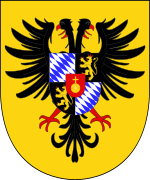 |
Quarterly, I and IV fusilly bendwise argent and azure (for Bavaria Bavaria Bavaria, formally the Free State of Bavaria is a state of Germany, located in the southeast of Germany. With an area of , it is the largest state by area, forming almost 20% of the total land area of Germany... ); II and III sable a lion rampant Or, armed, langued, and crowned gules (for the Electoral Palatinate); overall an inescutcheon gules an orb Or (for Arch-Steward of the Holy Roman Empire). |
 |
Quarterly, I barry of eight gules and argent (for Hungary Kingdom of Hungary The Kingdom of Hungary comprised present-day Hungary, Slovakia and Croatia , Transylvania , Carpatho Ruthenia , Vojvodina , Burgenland , and other smaller territories surrounding present-day Hungary's borders... ) impaling azure semy-de-lis Or a label gules (for Naples Kingdom of Naples The Kingdom of Naples, comprising the southern part of the Italian peninsula, was the remainder of the old Kingdom of Sicily after secession of the island of Sicily as a result of the Sicilian Vespers rebellion of 1282. Known to contemporaries as the Kingdom of Sicily, it is dubbed Kingdom of... ); II argent a cross potent and four crosslets Or (for Jerusalem Kingdom of Jerusalem The Kingdom of Jerusalem was a Catholic kingdom established in the Levant in 1099 after the First Crusade. The kingdom lasted nearly two hundred years, from 1099 until 1291 when the last remaining possession, Acre, was destroyed by the Mamluks, but its history is divided into two distinct periods.... ) impaling Or four pallets gules (for Aragon Kingdom of Aragon The Kingdom of Aragon was a medieval and early modern kingdom in the Iberian Peninsula, corresponding to the modern-day autonomous community of Aragon, in Spain... ); III azure semy-de-lis Or a bordure gules (for the House of Valois-Anjou House of Valois-Anjou The Valois House of Anjou, or the Younger House of Anjou, was a noble French family, deriving from the royal family, the House of Valois. They were monarchs of Naples, as well as various other territories.... ) impaling azure a lion sinister rampant Or, armed, langued, and crowned gules (for Guelders Guelders Guelders or Gueldres is the name of a historical county, later duchy of the Holy Roman Empire, located in the Low Countries.-Geography:... ); IV Or a lion rampant sable, armed and langued gules (for Jülich Duchy of Jülich The Duchy of Jülich comprised a state within the Holy Roman Empire from the 11th to the 18th centuries. The duchy lay left of the Rhine river between the Electorate of Cologne in the east and the Duchy of Limburg in the west. It had territories on both sides of the river Rur, around its capital... ) impaling azure crusilly fitchy, two barbels haurient addorsed Or (for Bar Counts and dukes of Bar Bar was a historic duchy of both the Holy Roman Empire and the crown of France, though later totally incorporated with Lorraine into France in 1766. The duchy of Bar includes the "pays" of Barrois.- History :... ); overall an inescutcheon Or a bend gules three alerions argent (for Lorraine Lorraine (province) The Duchy of Upper Lorraine was an historical duchy roughly corresponding with the present-day northeastern Lorraine region of France, including parts of modern Luxembourg and Germany. The main cities were Metz, Verdun, and the historic capital Nancy.... ) impaling Or, in annulo six torteaux, the torteau in chief replaced by a roundel azure charged with three fleurs-de-lis Or (for the Medici Medici The House of Medici or Famiglia de' Medici was a political dynasty, banking family and later royal house that first began to gather prominence under Cosimo de' Medici in the Republic of Florence during the late 14th century. The family originated in the Mugello region of the Tuscan countryside,... family). |
|
Quarterly, I barry of eight, gules and argent, impaling gules a patriarchal cross argent on a trimount vert (for Hungary Kingdom of Hungary The Kingdom of Hungary comprised present-day Hungary, Slovakia and Croatia , Transylvania , Carpatho Ruthenia , Vojvodina , Burgenland , and other smaller territories surrounding present-day Hungary's borders... ); II gules a lion rampant argent, queue fourchée crossed in saltire, armed, langued, and crowned Or (for Bohemia Kingdom of Bohemia The Kingdom of Bohemia was a country located in the region of Bohemia in Central Europe, most of whose territory is currently located in the modern-day Czech Republic. The King was Elector of Holy Roman Empire until its dissolution in 1806, whereupon it became part of the Austrian Empire, and... ); III bendy of six Or and azure, a bordure gules (for Burgundy Duke of Burgundy Duke of Burgundy was a title borne by the rulers of the Duchy of Burgundy, a small portion of traditional lands of Burgundians west of river Saône which in 843 was allotted to Charles the Bald's kingdom of West Franks... ); IV Or, in annulo six torteaux, the torteau in chief replaced by a roundel azure charged with three fleurs-de-lis Or (for the Medici Medici The House of Medici or Famiglia de' Medici was a political dynasty, banking family and later royal house that first began to gather prominence under Cosimo de' Medici in the Republic of Florence during the late 14th century. The family originated in the Mugello region of the Tuscan countryside,... family); overall and inescutcheon gules a fess argent (for Austria Archduchy of Austria The Archduchy of Austria , one of the most important states within the Holy Roman Empire, was the nucleus of the Habsburg Monarchy and the predecessor of the Austrian Empire... ) impaling Or a bend gules three alerions argent (for Lorraine Lorraine (province) The Duchy of Upper Lorraine was an historical duchy roughly corresponding with the present-day northeastern Lorraine region of France, including parts of modern Luxembourg and Germany. The main cities were Metz, Verdun, and the historic capital Nancy.... ). |
||
Quarterly, I barry of eight, gules and argent, impaling gules a patriarchal cross argent on a tri-mount vert (for Hungary Kingdom of Hungary The Kingdom of Hungary comprised present-day Hungary, Slovakia and Croatia , Transylvania , Carpatho Ruthenia , Vojvodina , Burgenland , and other smaller territories surrounding present-day Hungary's borders... ); II gules a lion rampant argent, queue fourchée crossed in saltire, armed, langued, and crowned Or (for Bohemia Kingdom of Bohemia The Kingdom of Bohemia was a country located in the region of Bohemia in Central Europe, most of whose territory is currently located in the modern-day Czech Republic. The King was Elector of Holy Roman Empire until its dissolution in 1806, whereupon it became part of the Austrian Empire, and... ); III bendy of six Or and azure, a bordure gules (for Burgundy Duke of Burgundy Duke of Burgundy was a title borne by the rulers of the Duchy of Burgundy, a small portion of traditional lands of Burgundians west of river Saône which in 843 was allotted to Charles the Bald's kingdom of West Franks... ); IV azure crusilly fitchy, two barbels haurient addorsed Or (for Bar Counts and dukes of Bar Bar was a historic duchy of both the Holy Roman Empire and the crown of France, though later totally incorporated with Lorraine into France in 1766. The duchy of Bar includes the "pays" of Barrois.- History :... ); overall an inescutcheon per pale, dexter Or a bend gules three alerions argent (for Lorraine Lorraine (province) The Duchy of Upper Lorraine was an historical duchy roughly corresponding with the present-day northeastern Lorraine region of France, including parts of modern Luxembourg and Germany. The main cities were Metz, Verdun, and the historic capital Nancy.... ), sinister Or, in annulo six torteaux, the torteau in chief replaced by a roundel azure charged with three fleurs-de-lis Or (for the Medici Medici The House of Medici or Famiglia de' Medici was a political dynasty, banking family and later royal house that first began to gather prominence under Cosimo de' Medici in the Republic of Florence during the late 14th century. The family originated in the Mugello region of the Tuscan countryside,... family), overall on a pale gules a fess argent (for Austria Archduchy of Austria The Archduchy of Austria , one of the most important states within the Holy Roman Empire, was the nucleus of the Habsburg Monarchy and the predecessor of the Austrian Empire... ). |
High offices (Reichserzämter)
| Arms | Office and Blazon Blazon In heraldry and heraldic vexillology, a blazon is a formal description of a coat of arms, flag or similar emblem, from which the reader can reconstruct the appropriate image... |
|---|---|
 |
Arch-Chamberlain of the Holy Roman Empire
|
 |
Arch-Steward of the Holy Roman Empire
Gules Gules In heraldry, gules is the tincture with the colour red, and belongs to the class of dark tinctures called "colours". In engraving, it is sometimes depicted as a region of vertical lines or else marked with gu. as an abbreviation.... , an orb Globus cruciger The globus cruciger is an orb topped with a cross , a Christian symbol of authority used throughout the Middle Ages and even today on coins, iconography and royal regalia... Or Or (heraldry) In heraldry, Or is the tincture of gold and, together with argent , belongs to the class of light tinctures called "metals". In engravings and line drawings, it may be represented using a field of evenly spaced dots... . |
 |
Arch-Treasurer of the Holy Roman Empire Gules, the crown of Charlemagne Imperial Crown of the Holy Roman Empire The Imperial Crown , is the hoop crown of the King of the Romans, the rulers of the German Kingdom, since the High Middle Ages. Most of the kings were crowned with it. It was made probably somewhere in Western Germany, either under Otto I , by Conrad II or Conrad III during the late 10th and early... proper. |
 |
Arch-Marshal of the Holy Roman Empire Per fess Division of the field In heraldry, the field of a shield can be divided into more than one area of different tinctures, usually following the lines of one of the ordinaries and carrying its name... sable Sable (heraldry) In heraldry, sable is the tincture black, and belongs to the class of dark tinctures, called "colours". In engravings and line drawings, it is sometimes depicted as a region of crossed horizontal and vertical lines or else marked with sa. as an abbreviation.The name derives from the black fur of... and argent Argent In heraldry, argent is the tincture of silver, and belongs to the class of light tinctures, called "metals". It is very frequently depicted as white and usually considered interchangeable with it... , two swords in saltire gules Gules In heraldry, gules is the tincture with the colour red, and belongs to the class of dark tinctures called "colours". In engraving, it is sometimes depicted as a region of vertical lines or else marked with gu. as an abbreviation.... . |
Electors
| Arms | Electorate/Blazon Blazon In heraldry and heraldic vexillology, a blazon is a formal description of a coat of arms, flag or similar emblem, from which the reader can reconstruct the appropriate image... |
 |
Bavaria (1623) Fusilly Lozenge (heraldry) The lozenge in heraldry is a diamond-shaped charge , usually somewhat narrower than it is tall. It is to be distinguished in modern heraldry from the fusil, which is like the lozenge but narrower, though the distinction has not always been as fine and is not always observed even today... bendwise Bend (heraldry) In heraldry, a bend is a coloured band running from the upper right corner of the shield to the lower left . Writers differ in how much of the field they say it covers, ranging from one-fifth up to one-third... argent and azure. |
 |
Bohemia Kingdom of Bohemia The Kingdom of Bohemia was a country located in the region of Bohemia in Central Europe, most of whose territory is currently located in the modern-day Czech Republic. The King was Elector of Holy Roman Empire until its dissolution in 1806, whereupon it became part of the Austrian Empire, and... Gules a lion Lion (heraldry) The lion is a common charge in heraldry. It traditionally symbolises bravery, valour, strength, and royalty, since traditionally, it is regarded as the king of beasts.-Attitudes:... rampant argent, queue fourchée crossed in saltire, armed, langued, and crowned Or. |
 |
Brandenburg Margraviate of Brandenburg The Margraviate of Brandenburg was a major principality of the Holy Roman Empire from 1157 to 1806. Also known as the March of Brandenburg , it played a pivotal role in the history of Germany and Central Europe.... Argent an eagle displayed gules crowned Or. |
 |
Cologne Argent a cross Cross A cross is a geometrical figure consisting of two lines or bars perpendicular to each other, dividing one or two of the lines in half. The lines usually run vertically and horizontally; if they run obliquely, the design is technically termed a saltire, although the arms of a saltire need not meet... sable. |
| Brunswick-Lüneburg Electorate of Hanover The Electorate of Brunswick-Lüneburg was the ninth Electorate of the Holy Roman Empire of the German Nation... (Hanover) (1692) Per pale, I Gules two lions Lion (heraldry) The lion is a common charge in heraldry. It traditionally symbolises bravery, valour, strength, and royalty, since traditionally, it is regarded as the king of beasts.-Attitudes:... passant guardant Or (for Brunswick Braunschweig Braunschweig , is a city of 247,400 people, located in the federal-state of Lower Saxony, Germany. It is located north of the Harz mountains at the farthest navigable point of the Oker river, which connects to the North Sea via the rivers Aller and Weser.... ), II Or a semy of hearts Gules a lion rampant Azure (for Lüneburg Lüneburg Lüneburg is a town in the German state of Lower Saxony. It is located about southeast of fellow Hanseatic city Hamburg. It is part of the Hamburg Metropolitan Region, and one of Hamburg's inner suburbs... ).
|
|
 |
Mainz Archbishopric of Mainz The Archbishopric of Mainz or Electorate of Mainz was an influential ecclesiastic and secular prince-bishopric in the Holy Roman Empire between 780–82 and 1802. In the Roman Catholic Church hierarchy, the Archbishop of Mainz was the primas Germaniae, the substitute of the Pope north of the Alps... Gules, a wheel with six spokes argent. |
Electoral Palatinate
|
|
 |
Saxony Electorate of Saxony The Electorate of Saxony , sometimes referred to as Upper Saxony, was a State of the Holy Roman Empire. It was established when Emperor Charles IV raised the Ascanian duchy of Saxe-Wittenberg to the status of an Electorate by the Golden Bull of 1356... Barry sable and Or, a crancelin vert Vert The colour green is commonly found in modern flags and coat of arms, and to a lesser extent also in the classical heraldry of the Late Middle Ages and the Early Modern period.... . |
 |
Trier Archbishopric of Trier The Archbishopric of Trier was a Roman Catholic diocese in Germany, that existed from Carolingian times until the end of the Holy Roman Empire. Its suffragans were the dioceses of Metz, Toul and Verdun. Since the 9th century the Archbishops of Trier were simultaneously princes and since the 11th... Argent a cross gules. |
Other states
Listed by Imperial CircleImperial Circle
An Imperial Circle comprised a regional grouping of territories of the Holy Roman Empire, primarily for the purpose of organizing a common defensive structure and of collecting the imperial taxes, but also as a means of organization within the Imperial Diet and the Imperial Chamber Court.Each...
(introduced 1500, 1512).
Austrian CircleAustrian CircleThe Austrian Circle was an Imperial Circle of the Holy Roman Empire. It was one of the four Imperial Circles created in 1512, 12 years after the original Reichsreform created six Circles....
| Arms | Location/Blazon Blazon In heraldry and heraldic vexillology, a blazon is a formal description of a coat of arms, flag or similar emblem, from which the reader can reconstruct the appropriate image... |
 |
Austria Archduchy of Austria The Archduchy of Austria , one of the most important states within the Holy Roman Empire, was the nucleus of the Habsburg Monarchy and the predecessor of the Austrian Empire... Gules Gules In heraldry, gules is the tincture with the colour red, and belongs to the class of dark tinctures called "colours". In engraving, it is sometimes depicted as a region of vertical lines or else marked with gu. as an abbreviation.... a fess Fess In heraldry, a fess or fesse is a charge on a coat of arms that takes the form of a band running horizontally across the centre of the shield. Writers disagree in how much of the shield's surface is to be covered by a fess or other ordinary, ranging from one-fifth to one-third... argent Argent In heraldry, argent is the tincture of silver, and belongs to the class of light tinctures, called "metals". It is very frequently depicted as white and usually considered interchangeable with it... . |
| Carinthia Duchy of Carinthia The Duchy of Carinthia was a duchy located in southern Austria and parts of northern Slovenia. It was separated from the Duchy of Bavaria in 976, then the first newly created Imperial State beside the original German stem duchies.... Or three lions Lion (heraldry) The lion is a common charge in heraldry. It traditionally symbolises bravery, valour, strength, and royalty, since traditionally, it is regarded as the king of beasts.-Attitudes:... passant sable armed and langued gules impaling Impalement (heraldry) In heraldry, impalement is the combination of two coats of arms side-by-side in one shield or escutcheon to denote union, most often that of a husband and wife, but also for ecclesiastical use... gules a fess argent. |
|
 |
Carniola Duchy of Carniola The Duchy of Carniola was an administrative unit of the Holy Roman Empire and the Habsburg Monarchy from 1364 to 1918. Its capital was Ljubljana... Argent an eagle displayed azure Azure In heraldry, azure is the tincture with the colour blue, and belongs to the class of tinctures called "colours". In engraving, it is sometimes depicted as a region of horizontal lines or else marked with either az. or b. as an abbreviation.... , armed, beaked, and langued gules, charged with a crescent Crescent In art and symbolism, a crescent is generally the shape produced when a circular disk has a segment of another circle removed from its edge, so that what remains is a shape enclosed by two circular arcs of different diameters which intersect at two points .In astronomy, a crescent... chequy gules and Or. |
 |
Friuli Friuli Friuli is an area of northeastern Italy with its own particular cultural and historical identity. It comprises the major part of the autonomous region Friuli-Venezia Giulia, i.e. the province of Udine, Pordenone, Gorizia, excluding Trieste... Azure Azure In heraldry, azure is the tincture with the colour blue, and belongs to the class of tinctures called "colours". In engraving, it is sometimes depicted as a region of horizontal lines or else marked with either az. or b. as an abbreviation.... an eagle displayed Or. |
 |
Styria Duchy of Styria The history of Styria concerns the region roughly corresponding to the modern Austrian state of Styria and the Slovene region of Styria from its settlement by Germans and Slavs in the Dark Ages until the present... Vert Vert The colour green is commonly found in modern flags and coat of arms, and to a lesser extent also in the classical heraldry of the Late Middle Ages and the Early Modern period.... , a panther rampant argent incensed proper. |
 |
Tyrol County of Tyrol The County of Tyrol, Princely County from 1504, was a State of the Holy Roman Empire, from 1814 a province of the Austrian Empire and from 1867 a Cisleithanian crown land of Austria-Hungary... Argent an eagle displayed gules, armed, beaked, and langued Or. |
Bavarian CircleBavarian CircleThe Bavarian Circle was an Imperial Circle of the Holy Roman Empire.The most significant state by far in the circle was the Duchy of Bavaria , with the states of the Upper Palatinate, the Archbishopric of Salzburg, and the imperial city of Regensburg having a secondary importance.- Composition...
| Arms | Location and blazon |
|---|---|
  |
Bavaria Bavaria Bavaria, formally the Free State of Bavaria is a state of Germany, located in the southeast of Germany. With an area of , it is the largest state by area, forming almost 20% of the total land area of Germany...
|
 |
Haag Haag in Oberbayern Haag in Oberbayern is a municipality in the district of Mühldorf in Bavaria in Germany.... Gules, a horse springing argent, bridled argent. |
 |
Leuchtenberg Leuchtenberg Leuchtenberg is a municipality in the district of Neustadt in Bavaria in Germany, essentially a suburb of nearby Weiden in der Oberpfalz, and a historical region in Old Germany governed by the Landgrave of Leuchtenberg.... Quarterly: I and IV gules, an oak Oak An oak is a tree or shrub in the genus Quercus , of which about 600 species exist. "Oak" may also appear in the names of species in related genera, notably Lithocarpus... branch with acorn Acorn The acorn, or oak nut, is the nut of the oaks and their close relatives . It usually contains a single seed , enclosed in a tough, leathery shell, and borne in a cup-shaped cupule. Acorns vary from 1–6 cm long and 0.8–4 cm broad... s Or; II and III Or, a hops Hops Hops are the female flower clusters , of a hop species, Humulus lupulus. They are used primarily as a flavoring and stability agent in beer, to which they impart a bitter, tangy flavor, though hops are also used for various purposes in other beverages and herbal medicine... branch vert; an inescutcheon argent a fess azure. |
 |
Ortenburg Gules, a bend embattled-counter-embattled Line (heraldry) The lines of partition used to divide and vary fields and charges in heraldry are by default straight, but may have many different shapes. Care must sometimes be taken to distinguish these types of lines from the extremely unusual and non-traditional use of lines as charges, and to distinguish... argent |
| Passau Argent a wolf gules |
|
 |
Regensburg Bishopric of Regensburg The Bishopric of Regensburg was a small prince-bishopric of the Holy Roman Empire, located in what is now southern Germany. It was elevated to the Archbishopric of Regensburg in 1803 after the dissolution of the Archbishopric of Mainz, but became a bishopric again in 1817.-History:The diocese... Gules, two keys in saltire Saltire A saltire, or Saint Andrew's Cross, is a heraldic symbol in the form of a diagonal cross or letter ex . Saint Andrew is said to have been martyred on such a cross.... argent. |
 |
Salzburg Party per pale: Or a lion rampant sable, armed and langued gules; and gules a fess argent. |
Burgundian CircleBurgundian CircleThe Burgundian Circle was an Imperial Circle of the Holy Roman Empire created in 1512 and significantly enlarged in 1548. In addition to the Free County of Burgundy , the circle roughly covered the Low Countries, i.e...
| Arms | Location/Blazon Blazon In heraldry and heraldic vexillology, a blazon is a formal description of a coat of arms, flag or similar emblem, from which the reader can reconstruct the appropriate image... |
.svg.png) |
County of Burgundy
|
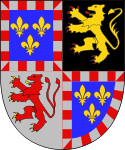 |
Brabant
|
| Flanders
Or a lion rampant sable. |
|
.svg.png) 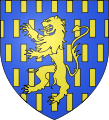 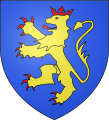 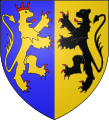 |
Guelders Guelders Guelders or Gueldres is the name of a historical county, later duchy of the Holy Roman Empire, located in the Low Countries.-Geography:...
|
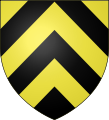   |
Hainaut Counts of Hainaut The counts of Hainaut were the rulers of the county of Hainaut, a historical region in the Low Countries .-House of Reginar:...
|
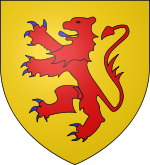 |
Holland Count of Holland The Counts of Holland ruled over the County of Holland in the Low Countries between the 10th and the 16th century.-House of Holland:The first count of Holland, Dirk I, was the son or foster-son of Gerolf, Count in Frisia... Or a lion rampant gules, armed and langued azure. |
 |
Limburg
|
 |
Loon County of Loon The County of Loon was a state of the Holy Roman Empire, lying west of the Meuse river in present-day Flemish-speaking Belgium, and east of the old Duchy of Brabant. The most important cities of the county were Beringen, Bilzen, Borgloon, Bree, Hamont, Hasselt, Herk-de-Stad, Maaseik, Peer and... and Chiny Chiny Chiny is a Walloon municipality of Belgium located in the province of Luxembourg.On 1 January 2007 the municipality, which covers , had 5,021 inhabitants, giving a population density of 44.2 inhabitants per km²...
|
Luxembourg
|
|
| Namur Marquis of Namur Namur was a county of the Carolingian and later Holy Roman Empire in the Low Countries. Its territories largely correspond with the present-day Belgian arrondissement Namur plus the northwestern part of the arrondissement Dinant.... Or, a lion rampant sable, armed and langued gules, a bend Bend (heraldry) In heraldry, a bend is a coloured band running from the upper right corner of the shield to the lower left . Writers differ in how much of the field they say it covers, ranging from one-fifth up to one-third... overall of the same. |
Franconian CircleFranconian CircleThe Franconian Circle was an Imperial Circle established in 1500 in the centre of the Holy Roman Empire. It comprised the eastern part of the former Franconian stem duchy — roughly corresponding with the present-day Bavarian Regierungsbezirke of Upper, Middle and Lower Franconia — while western...
| Arms | Location and blazon |
|---|---|
 |
Bamberg Or Or (heraldry) In heraldry, Or is the tincture of gold and, together with argent , belongs to the class of light tinctures called "metals". In engravings and line drawings, it may be represented using a field of evenly spaced dots... , a lion Lion (heraldry) The lion is a common charge in heraldry. It traditionally symbolises bravery, valour, strength, and royalty, since traditionally, it is regarded as the king of beasts.-Attitudes:... rampant armed and langued gules Gules In heraldry, gules is the tincture with the colour red, and belongs to the class of dark tinctures called "colours". In engraving, it is sometimes depicted as a region of vertical lines or else marked with gu. as an abbreviation.... , overall a ribband Bend (heraldry) In heraldry, a bend is a coloured band running from the upper right corner of the shield to the lower left . Writers differ in how much of the field they say it covers, ranging from one-fifth up to one-third... argent Argent In heraldry, argent is the tincture of silver, and belongs to the class of light tinctures, called "metals". It is very frequently depicted as white and usually considered interchangeable with it... . |
 |
Castell Quarterly Division of the field In heraldry, the field of a shield can be divided into more than one area of different tinctures, usually following the lines of one of the ordinaries and carrying its name... , argent and gules. |
 |
Erbach Erbach im Odenwald -Location:The town lies in the Odenwald at elevations between 200 and 560 m in the valley of the Mümling.-Neighbouring communities:Erbach borders in the north on the town of Michelstadt, in the east on the market town of Kirchzell , in the south on the community of Hesseneck and the town of... Party per fess Division of the field In heraldry, the field of a shield can be divided into more than one area of different tinctures, usually following the lines of one of the ordinaries and carrying its name... gules and argent, three six-pointed mullets counterchanged. |
 |
Hausen Hausen, Upper Franconia Hausen is a municipality in the district of Forchheim in Bavaria in Germany.... Party per fess, in chief Or, a demi-waterwheel sable Sable The sable is a species of marten which inhabits forest environments, primarily in Russia from the Ural Mountains throughout Siberia, in northern Mongolia and China and on Hokkaidō in Japan. Its range in the wild originally extended through European Russia to Poland and Scandinavia... ; in base per pale, dexter per chevron issuing from the dexter chief sable and gules a chevron issuing from the dexter chief argent, sinister argent a palm leaf gules. |
 |
Hohenlohe Hohenlohe Hohenlohe is the name of a German princely family and the name of their principality.At first rulers of a county, its two branches were raised to the rank of principalities of the Holy Roman Empire in 1744 and 1764 respectively; in 1806 they lost their independence and their lands formed part of... Argent, two lions passant guardant sable, langued gules. |
 |
Löwenstein-Wertheim Löwenstein-Wertheim Löwenstein-Wertheim was a county of the Holy Roman Empire, part of the Franconian Circle. It was formed from the counties of Löwenstein and Wertheim .... Party per fess: fusily argent and azure Azure In heraldry, azure is the tincture with the colour blue, and belongs to the class of tinctures called "colours". In engraving, it is sometimes depicted as a region of horizontal lines or else marked with either az. or b. as an abbreviation.... ; and Or, a lion statant gules, atop a mount azure. |
 |
Nuremberg Nuremberg Nuremberg[p] is a city in the German state of Bavaria, in the administrative region of Middle Franconia. Situated on the Pegnitz river and the Rhine–Main–Danube Canal, it is located about north of Munich and is Franconia's largest city. The population is 505,664... Or, a double-headed eagle Double-headed eagle The double-headed eagle is a common symbol in heraldry and vexillology. It is most commonly associated with the Byzantine Empire and the Holy Roman Empire. In Byzantine heraldry, the heads represent the dual sovereignty of the Emperor and/or dominance of the Byzantine Emperors over both East and... sable dimidiating Dimidiation In heraldry, dimidiation is a method of joining two coats of arms.For a time, dimidiation preceded the method known as impalement. Whereas impalement involves placing the whole of both coats of arms side by side in the same shield, dimidiation involves placing the dexter half of one coat of arms... bendy gules and argent. |
 |
Rieneck Rieneck Rieneck is a town in the Main-Spessart district in the Regierungsbezirk of Lower Franconia in Bavaria, Germany.- Location :... Quarterly: chevrony Or and gules; and barry Or and gules; overall a Wheel of Mainz Wheel of Mainz thumb|150px|version until 1992thumb|150px|version from 1992 - 2008thumb|150px|version from 2008The Wheel of Mainz or Mainzer Rad, in German, was the coat of arms of the Archbishopric of Mainz and thus also of the Electorate of Mainz , in Rhineland-Palatinate, Germany. It consists of a silver wheel... argent. |
 |
Rothenburg ob der Tauber Rothenburg ob der Tauber Rothenburg ob der Tauber is a town in the district of Ansbach of Mittelfranken , the Franconia region of Bavaria, Germany, well known for its well-preserved medieval old town, a destination for tourists from around the world. In the Middle Ages, it was an Imperial Free City... Argent, a double-towered castle gules. |
 |
Schwarzenberg House of Schwarzenberg -History:The family was first mentioned in 1172. A branch of the Seinsheim family was created when Erkinger I of Seinsheim acquired the Franconian barony of Schwarzenberg, the castle Schwarzenberg and the title Baron of Schwarzenberg, in 1405–21. At this time, they also possessed some fiefdoms in... Quarterly: paley azure and argent; Or, a raven Raven Raven is the common name given to several larger-bodied members of the genus Corvus—but in Europe and North America the Common Raven is normally implied... pecking the eye out of a Turk's head Ottoman Empire The Ottoman EmpireIt was usually referred to as the "Ottoman Empire", the "Turkish Empire", the "Ottoman Caliphate" or more commonly "Turkey" by its contemporaries... couped at the neck proper. |
 |
Schweinfurt Schweinfurt Schweinfurt is a city in the Lower Franconia region of Bavaria in Germany on the right bank of the canalized Main, which is here spanned by several bridges, 27 km northeast of Würzburg.- History :... Azure an eagle Eagle (heraldry) The eagle is used in heraldry as a charge, as a supporter, and as a crest. Parts of the eagle's body such as its head, wings or leg are also used as a charge or crest.... displayed argent. |
 |
Seinsheim Seinsheim Seinsheim is a municipality in the district of Kitzingen in Bavaria in Germany. It is best known for its connection with the countly Seinsheim family which died out with the exception of the princely House of Schwarzenberg branch of the family.... Argent, three pallets azure, a bend sinister wavy Or. |
 |
Weißenburg im Nordgau Gules, a castle argent, portcullised Or, with an escutcheon of the Imperial arms (Or, a double-headed eagle sable) at the honour point. |
 |
Welzheim Welzheim Welzheim is a town in the Rems-Murr district, in Baden-Württemberg, Germany. It is located 35 km east of Stuttgart, and 15 km northwest of Schwäbisch Gmünd.... Argent, a pine tree on a mount Vert Vert The colour green is commonly found in modern flags and coat of arms, and to a lesser extent also in the classical heraldry of the Late Middle Ages and the Early Modern period.... . |
 |
Wertheim Party per fess: Or, a demi-eagle displayed sable; and azure three roses Rose (heraldry) The rose is a common device in heraldry. It is often used both as a charge on a coat of arms and by itself as a heraldic badge. The heraldic rose has a stylized form consisting of five symmetrical lobes, five barbs, and a circular seed. The rose is one of the most common plant symbols in... argent. |
 |
Wiesentheid Wiesentheid Wiesentheid is a municipality in the district of Kitzingen in Bavaria in Germany.-History:First time vouched in 918 as "wisenheida". The Mediatization in 1806 brought former shire Schönborn to grand duchy Würzburg so that in 1814 it belonged to Bavaria again... Gules, a lion passant reversed Or, crowned Or; with three stems of grass surtout, all on a mount Vert. |
 |
Windsheim Argent, an eagle sable, armed and langued Or, with a W W W is the 23rd letter in the basic modern Latin alphabet.In other Germanic languages, including German, its pronunciation is similar or identical to that of English V... Or on the breast. |
| Würzburg Bishopric of Würzburg The Bishopric of Würzburg was a prince-bishopric in the Holy Roman Empire, located in Lower Franconia, around the city of Würzburg, Germany. Würzburg was a diocese from 743. In the 18th century, its bishop was often also Bishop of Bamberg... Argent a Celtic cross Celtic cross A Celtic cross is a symbol that combines a cross with a ring surrounding the intersection. In the Celtic Christian world it was combined with the Christian cross and this design was often used for high crosses – a free-standing cross made of stone and often richly decorated... sable; a chief dancetty gules (de German language German is a West Germanic language, related to and classified alongside English and Dutch. With an estimated 90 – 98 million native speakers, German is one of the world's major languages and is the most widely-spoken first language in the European Union.... ). |
Lower Rhenish-Westphalian CircleLower Rhenish-Westphalian CircleThe Lower Rhenish–Westphalian Circle was an Imperial Circle of the Holy Roman Empire. It comprised territories of the former Duchy of Lower Lorraine, Frisia and the Westphalian part of the former Duchy of Saxony....
| Arms | Location/Blazon Blazon In heraldry and heraldic vexillology, a blazon is a formal description of a coat of arms, flag or similar emblem, from which the reader can reconstruct the appropriate image... |
 |
Cleves Duchy of Cleves The Duchy of Cleves was a State of the Holy Roman Empire. It was situated in the northern Rhineland on both sides of the Lower Rhine, around its capital Cleves and the town of Wesel, bordering the lands of the Prince-Bishopric of Münster in the east and the Duchy of Brabant in the west...
|
 |
Berg Berg (state) Berg was a state – originally a county, later a duchy – in the Rhineland of Germany. Its capital was Düsseldorf. It existed from the early 12th to the 19th centuries.-Ascent:... Argent a lion rampant gules, queue fourchée crossed in saltire, armed, langued, and crowned Or. |
| Jülich Duchy of Jülich The Duchy of Jülich comprised a state within the Holy Roman Empire from the 11th to the 18th centuries. The duchy lay left of the Rhine river between the Electorate of Cologne in the east and the Duchy of Limburg in the west. It had territories on both sides of the river Rur, around its capital... Or a lion rampant sable, armed and langued gules. |
|
| Liège Quarterly: I: gules a fess argent; II: Argent, three lions rampant vert, crowned or, armed and langued gules; III: Barry gules and or; IV: Or, three hunting horns gules, hooped and belted argent. Overall an inescutcheon gules, a perron or, supported by three lions, surmounted by a pineapple and a cross pattée, with the capital letters L and G aside, all of the same. |
|
 |
Mark
|
 |
Ravensberg
Argent three chevrons gules. |
Upper Rhenish CircleUpper Rhenish CircleThe Upper Rhenish Circle was an Imperial Circle of the Holy Roman Empire established in 1500 on the territory of the former Duchy of Upper Lorraine and large parts of Rhenish Franconia including the Swabian Alsace region and the Burgundian duchy of Savoy....
| Arms | Location/Blazon Blazon In heraldry and heraldic vexillology, a blazon is a formal description of a coat of arms, flag or similar emblem, from which the reader can reconstruct the appropriate image... |
 |
Hesse Landgraviate of Hesse The Landgraviate of Hesse was a Landgraviate of the Holy Roman Empire. It existed as a unity from 1264 to 1567, when it was divided between the sons of Philip I, Landgrave of Hesse.-History:... Azure a lion rampant barry argent and gules. |
 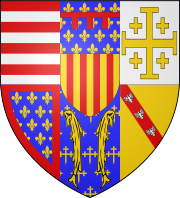  |
Lorraine Lorraine (province) The Duchy of Upper Lorraine was an historical duchy roughly corresponding with the present-day northeastern Lorraine region of France, including parts of modern Luxembourg and Germany. The main cities were Metz, Verdun, and the historic capital Nancy....
|
 |
Savoy House of Savoy The House of Savoy was formed in the early 11th century in the historical Savoy region. Through gradual expansion, it grew from ruling a small county in that region to eventually rule the Kingdom of Italy from 1861 until the end of World War II, king of Croatia and King of Armenia... Gules a cross argent. |
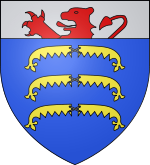 |
Vaudémont Vaudémont Vaudémont is a commune in the Meurthe-et-Moselle department in north-eastern France.-See also:*Communes of the Meurthe-et-Moselle department...
|
Electoral Rhenish CircleElectoral Rhenish CircleThe Electoral Rhenish Circle was an Imperial Circle of the Holy Roman Empire, created in 1512.The circle derived its name from four of the seven prince-electors whose lands along the Middle Rhine comprised the vast majority of its territory....
| Arms | Location and blazon |
|---|---|
| Arenberg Arenberg Arenberg, also spelled as Aremberg or Ahremberg, is a historic county, principality and finally duchy located in modern Germany. The Dukes of Arenberg remain a prominent Belgian aristocratic family.- History :... Gules Gules In heraldry, gules is the tincture with the colour red, and belongs to the class of dark tinctures called "colours". In engraving, it is sometimes depicted as a region of vertical lines or else marked with gu. as an abbreviation.... , three estoiles Or Or (heraldry) In heraldry, Or is the tincture of gold and, together with argent , belongs to the class of light tinctures called "metals". In engravings and line drawings, it may be represented using a field of evenly spaced dots... voided; on a chief Chief (heraldry) In heraldic blazon, a chief is a charge on a coat of arms that takes the form of a band running horizontally across the top edge of the shield. Writers disagree in how much of the shield's surface is to be covered by the chief, ranging from one-fourth to one-third. The former is more likely if the... Or three torteaux Roundel A roundel in heraldry is a disc; the term is also commonly used to refer to a type of national insignia used on military aircraft, generally circular in shape and usually comprising concentric rings of different colours.-Heraldry:... . |
|
 |
Beilstein Beilstein, Rhineland-Palatinate Beilstein is an Ortsgemeinde – a municipality belonging to a Verbandsgemeinde, a kind of collective municipality – in the Cochem-Zell district in Rhineland-Palatinate, Germany. It belongs to the Verbandsgemeinde of Cochem, whose seat is in the like-named town.- History :Finds from Frankish graves... Gules, a hunting horn argent Argent In heraldry, argent is the tincture of silver, and belongs to the class of light tinctures, called "metals". It is very frequently depicted as white and usually considered interchangeable with it... , bound Or. |
 |
Cologne Argent a cross Cross A cross is a geometrical figure consisting of two lines or bars perpendicular to each other, dividing one or two of the lines in half. The lines usually run vertically and horizontally; if they run obliquely, the design is technically termed a saltire, although the arms of a saltire need not meet... sable. |
 |
Lower Isenburg Argent two bars sable. |
 |
Mainz Archbishopric of Mainz The Archbishopric of Mainz or Electorate of Mainz was an influential ecclesiastic and secular prince-bishopric in the Holy Roman Empire between 780–82 and 1802. In the Roman Catholic Church hierarchy, the Archbishop of Mainz was the primas Germaniae, the substitute of the Pope north of the Alps... Gules, a wheel argent. |
Electoral Palatinate
|
|
| Thurn und Taxis Thurn und Taxis The Princely House of Thurn and Taxis is a German family that was a key player in the postal services in Europe in the 16th century and is well known as owners of breweries and builders of many castles.- History :... Quarterly: argent, two sceptre Sceptre A sceptre is a symbolic ornamental rod or wand borne in the hand by a ruling monarch as an item of royal or imperial insignia.-Antiquity:... s Or in saltire Saltire A saltire, or Saint Andrew's Cross, is a heraldic symbol in the form of a diagonal cross or letter ex . Saint Andrew is said to have been martyred on such a cross.... , tipped with fleurs-de-lys Fleur de Lys Fleur de Lys is a superheroine from Quebec and an ally of Northguard, created in 1984 by Mark Shainblum and Gabriel Morrissette. The name of the character is inspired by the heraldic symbol of the fleur de lys. It is the official emblem of Quebec and a prominent part of the Flag of Quebec... Or, overall a tower gules, ajouré azure; and Or a lion gules, crowned, armed and langued azure; overall an escutcheon: azure, a badger Badger Badgers are short-legged omnivores in the weasel family, Mustelidae. There are nine species of badger, in three subfamilies : Melinae , Mellivorinae , and Taxideinae... argent. |
|
 |
Trier Archbishopric of Trier The Archbishopric of Trier was a Roman Catholic diocese in Germany, that existed from Carolingian times until the end of the Holy Roman Empire. Its suffragans were the dioceses of Metz, Toul and Verdun. Since the 9th century the Archbishops of Trier were simultaneously princes and since the 11th... Argent a cross gules. |
Lower Saxon CircleLower Saxon CircleThe Lower Saxon Circle was an Imperial Circle of the Holy Roman Empire. Covering much of the territory of the mediæval Duchy of Saxony , firstly the circle used to be called the Saxon Circle , only to be later better differentiated from the Upper Saxon Circle the more specific name prevailed.An...
| Arms | Location |
 |
Holstein Holstein Holstein is the region between the rivers Elbe and Eider. It is part of Schleswig-Holstein, the northernmost state of Germany.... Gules, a nesselblatt Nettle Nettles constitute between 24 and 39 species of flowering plants of the genus Urtica in the family Urticaceae, with a cosmopolitan though mainly temperate distribution. They are mostly herbaceous perennial plants, but some are annual and a few are shrubby... argent. |
Upper Saxon CircleUpper Saxon CircleThe Upper Saxon Circle was an Imperial Circle of the Holy Roman Empire, created in 1512.The circle was dominated by the electorate of Saxony and the electorate of Brandenburg. It further comprised the Saxon Ernestine duchies and Pomerania...
| Arms | Location/Blazon Blazon In heraldry and heraldic vexillology, a blazon is a formal description of a coat of arms, flag or similar emblem, from which the reader can reconstruct the appropriate image... |
 |
Brandenburg Margraviate of Brandenburg The Margraviate of Brandenburg was a major principality of the Holy Roman Empire from 1157 to 1806. Also known as the March of Brandenburg , it played a pivotal role in the history of Germany and Central Europe.... Argent an eagle displayed gules crowned Or. |
| Pomerania Duchy of Pomerania The Duchy of Pomerania was a duchy in Pomerania on the southern coast of the Baltic Sea, ruled by dukes of the House of Pomerania .... |
|
 |
Saxony Electorate of Saxony The Electorate of Saxony , sometimes referred to as Upper Saxony, was a State of the Holy Roman Empire. It was established when Emperor Charles IV raised the Ascanian duchy of Saxe-Wittenberg to the status of an Electorate by the Golden Bull of 1356... Barry sable and Or, a crancelin vert Vert The colour green is commonly found in modern flags and coat of arms, and to a lesser extent also in the classical heraldry of the Late Middle Ages and the Early Modern period.... . |
Swabian CircleSwabian CircleThe Swabian Circle was an Imperial Circle of the Holy Roman Empire established in 1500 on the territory of the former German stem-duchy of Swabia. However, it did not include the Habsburg home territories of Swabian Austria, the member states of the Swiss Confederacy nor the lands of the Alsace...
| Arms | Location/Blazon Blazon In heraldry and heraldic vexillology, a blazon is a formal description of a coat of arms, flag or similar emblem, from which the reader can reconstruct the appropriate image... |
| Augsburg Augsburg Augsburg is a city in the south-west of Bavaria, Germany. It is a university town and home of the Regierungsbezirk Schwaben and the Bezirk Schwaben. Augsburg is an urban district and home to the institutions of the Landkreis Augsburg. It is, as of 2008, the third-largest city in Bavaria with a... |
|
 |
Baden Baden Baden is a historical state on the east bank of the Rhine in the southwest of Germany, now the western part of the Baden-Württemberg of Germany.... Or a bend gules. |
| Fugger Fugger The Fugger family was a historically prominent group of European bankers, members of the fifteenth and sixteenth-century mercantile patriciate of Augsburg, international mercantile bankers, and venture capitalists like the Welser and the Höchstetter families. This banking family replaced the de'... Per pale Or and azure, two fleur-de-lis counterchanged. |
|
| Salem Abbey Salem Abbey Salem Abbey , also known as Salmansweiler and in Latin as Salomonis Villa, was a very prominent Cistercian monastery in Salem in the district of Bodensee about ten miles from Konstanz, Baden-Württemberg, Germany.-Abbey:The abbey was founded in 1136 by Gunthram of Adelsreute Salem Abbey (Kloster or... |
|
 |
Teck Duke of Teck Duke of Teck was, in medieval times, a title borne by the head of a principality named Teck in the Holy Roman Empire, centered around Teck castle in Germany. That territory was held by a branch line of the Zähringen dynasty from 1187 to 1439, known historically as the first House of Teck... Fusilly bendwise sinister sable and Or. |
BohemiaBohemiaBohemia is a historical region in central Europe, occupying the western two-thirds of the traditional Czech Lands. It is located in the contemporary Czech Republic with its capital in Prague...
| Arms | Location/Blazon Blazon In heraldry and heraldic vexillology, a blazon is a formal description of a coat of arms, flag or similar emblem, from which the reader can reconstruct the appropriate image... |
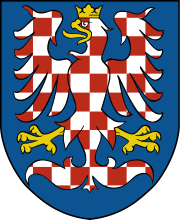 |
Moravia Moravia Moravia is a historical region in Central Europe in the east of the Czech Republic, and one of the former Czech lands, together with Bohemia and Silesia. It takes its name from the Morava River which rises in the northwest of the region... Azure an eagle displayed chequy argent and gules, crowned Or. |
| Görlitz Görlitz Görlitz is a town in Germany. It is the easternmost town in the country, located on the Lusatian Neisse River in the Bundesland of Saxony. It is opposite the Polish town of Zgorzelec, which was a part of Görlitz until 1945. Historically, Görlitz was in the region of Upper Lusatia... Per fess, chief gules a lion rampant argent, armed, langued, and crowned Or; base argent. |
|
| Lusatia Lusatia Lusatia is a historical region in Central Europe. It stretches from the Bóbr and Kwisa rivers in the east to the Elbe valley in the west, today located within the German states of Saxony and Brandenburg as well as in the Lower Silesian and Lubusz voivodeships of western Poland...
|
|
| Silesia Silesia Silesia is a historical region of Central Europe located mostly in Poland, with smaller parts also in the Czech Republic, and Germany.Silesia is rich in mineral and natural resources, and includes several important industrial areas. Silesia's largest city and historical capital is Wrocław... Or, an eagle sable, charged with a crescent with cross argent, crowned or. |
Other
| Arms | Location/Blazon Blazon In heraldry and heraldic vexillology, a blazon is a formal description of a coat of arms, flag or similar emblem, from which the reader can reconstruct the appropriate image... |
.svg.png) |
Geneva (before 1401) Or a cross quarter-pierced azure. |
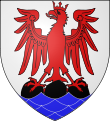 |
Nice County of Nice The County of Nice or Niçard Country is a historical region of France, located in the south-eastern part, around the city of Nice.-History:Its territory lies between the Mediterranean Sea , Var River and the southernmost crest of the... (as part of the Duchy of Savoy Duchy of Savoy From 1416 to 1847, the House of Savoy ruled the eponymous Duchy of Savoy . The Duchy was a state in the northern part of the Italian Peninsula, with some territories that are now in France. It was a continuation of the County of Savoy... from 1046) Argent, an eagle displayed crowned gules standing upon three rocks sable issuing from the sea azure issuing from the base. |
 |
Provence (before 1481)
|
| Prussia Kingdom of Prussia The Kingdom of Prussia was a German kingdom from 1701 to 1918. Until the defeat of Germany in World War I, it comprised almost two-thirds of the area of the German Empire... (after 1701) Argent, an eagle displayed sable crowned Or. |
|
 |
Teutonic Knights (1224–1525)
|
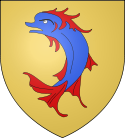 |
Viennois (before 1349)
Or, a dolphin haurient azure finned gules. |

